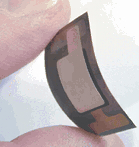May 7, 2003 – Infinite Power Solutions of Golden, Colorado, has begun a pilot production line that can turn out up to one million rechargeable thin-film batteries per year. Two potential markets are smart active labels and RFID sensors.
“One unique feature of our battery technology is it is rechargeable orders of magnitude more than other batteries,” says Matt Foster, president of Infinite Power. “You can put it in a product or sensor or RFID tag, and it will last as long as the device itself.”
Infinite Power is a member of the Smart Active Label consortium, which aims to set standards for and promote awareness of battery-powered RFID labels. The company’s flexible, thin-film batteries, which can be less than 5 millimeters thick, put out four volts and have a capacity of about 200 micro-amp hours per square centimeter (.4 inch).
Infinite Power has developed several methods for recharging the battery by collecting ambient energy. These including taking advantage of changes in temperature, vibrations, or motion. The batteries can also be recharged directly from a power source or using RF energy. They are currently being used in smart cards, micro-electronic and medical applications.
Foster says the cost of the batteries is typically $1 to $10 depending on volume and the application. Infinite Power is not trying to compete with button cell batteries, which cost about 15 cents. Instead, it is focusing on applications where the battery’s unique properties are needed. Those properties include a long operational life and the battery’s ability to function normally at temperatures ranging from -50 to 120 degrees Celsius.
One potential application is a tire pressure and temperature sensor. The company actually built a complete module for this application and got some interest from tire makers. But Foster is looking to work with a partner who can help fund research into ways to bring the cost down. The company is also looking to work with partners to create RFID sensors.
“Our technology is ideal for this kind of application because you typically are not consuming large amounts of power,” he says. “If you are monitoring something on a daily or weekly basis, it doesn’t require a lot of energy to transmit the information. The problem with most batteries is you put them out in the field for ten years and they just drain. Ours doesn’t.”
The aim of setting up the pilot production line is to learn about the production issues and how to optimize a full-scale production line. Another goal is to begin seeding the market and developing applications for the technology.
Eventually, the company hopes to be producing hundreds of millions of batteries per year. But it faces a common chicken-and-egg problem: The world won’t consume that many batteries until the price falls to below a dime, and the price won’t come down to that level until volume ramps up.
“Economics are the key for this technology,” says Foster. “It’s an enabling technology, and the killer applications haven’t even been thought of yet. So, what we’re trying to do is expose industries to the capabilities. If we were cheaper than a button cell battery today, everyone would be looking to buy it.”
Learn how RFID can benefit your company. Register for RFID Journal Live!, an executive conference being held in Chicago from June 11 to 13, 2003.


